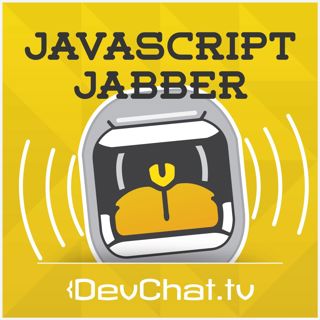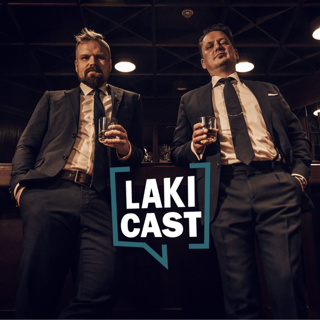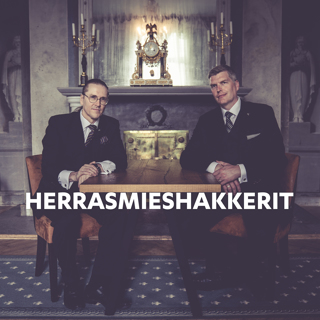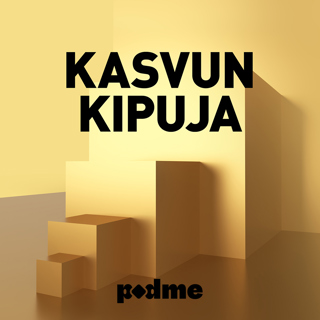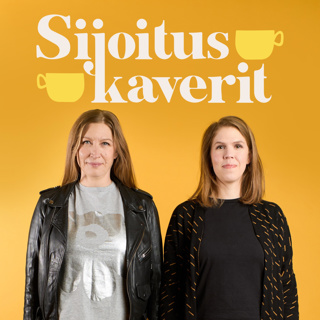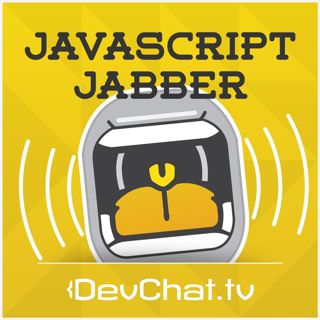
JSJ 349: Agile Development - The Technical Side with James Shore
SponsorsKendoUISentry use the code “devchat” for $100 credit ClubhousePanelAJ O’NealAimee KnightJoe EamesCharles Max WoodSpecial Guest: James ShoreEpisode Summary James Shore is a developer who specializing in extreme programming, an Agile method. He also used to host a screencast called Let’s Code Test-Driven JavaScript. They begin by discussing the core of Agile development, which James believes is being responsive to customers and business partners in a way that’s sustainable and humane for the programmers involved. It prioritizes individuals and interactions over processes and tools. More can be found in The Agile Manifesto. James delves into the historical context of the immersion of Agile and how things have changed from the 90’s. Now, the name Agile is everywhere, but the ideals of agile are not as common. There is a tendency to either take Agile buzzwords and apply them to the way it was done long ago, or it’s absolute chaos. James talks about ways to implement Agile in the workplace. He believes that the best way to learn Agile is work with someone who knows Agile, or read a book on it and then apply it. James recommends his book The Art of Agile Development: Pragmatic Guide to Agile Software Development for people who want to started with Agile development. The panelists talk about where people often get stuck with implementing Agile. The hosts talk about their own processes in their company. They discuss how people involved in the early days of Agile are disappointed in how commercial it has become.They agree that what’s really the most important is the results. If you can respond to a request to change direction in less than two weeks and you don’t have to spend months and months preparing something, and you do that in a way where the people on the team feel like their contributing, then you’re doing Agile. James thinks that the true genius of Agile is in the way the actual work is done rather than in the way your organize the work. LinksAgileScrumWaterfallFeature Driven DevelopmentExtreme Programming (XP)JiraBambooConfluenceAtlassian stackCowboyMock objectsGrows Method by Andy Hunt PicksAJ O’Neal:Origin by Dan Brown SearchingAimee Knight:Hacker News Interview Questions Thread.Joe Eames:The Ballad of Buster Scruggs on NetflixCharles Max Wood:Getting up early John Sonmez Kanbanflow videoDripJames Shore:Lost in Space on NetflixStar Citizen PC game Jame’s Agile book onlineSpecial Guest: James Shore. Support this podcast at — https://redcircle.com/javascript-jabber/donationsPrivacy & Opt-Out: https://redcircle.com/privacyBecome a supporter of this podcast: https://www.spreaker.com/podcast/javascript-jabber--6102064/support.
30 Tammi 201959min

JSJ 348: EnactJS with Ryan Duffy
Sponsors- https://www.telerik.com/kendo-ui?utm_campaign=kendo-ui-awareness-jsjabber&utm_medium=social-paid&utm_source=devchattv- http://sentry.io use the code "devchat" for $100 credit- https://clubhouse.io/jsjabber- https://www.cachefly.com/PanelAimee KnightAaron FrostChris FerdinandiJoe EamesSpecial Guest: Ryan Duffy In this episode of JavaScript Jabber, the panelists talk with Ryan Duffy who works on the EnactJS framework at LG Electronics. Ryan explains the framework in depth and answers all the questions about its design and implementation from the panelists and discusses some challenges faced along the way. Check it out! Show Notes:00:28 – Advertisement - https://www.telerik.com/kendo-ui?utm_campaign=kendo-ui-awareness-jsjabber&utm_medium=social-paid&utm_source=devchattv 1:08 - Ryan introduces himself and explains a bit about the EnactJS framework. While giving some background, he says that it is the 3rd generation of web frameworks that supports apps on webOS and they started building Enact on top of React about two years ago.2:00 - Aimee asks what exactly does webOS mean. Ryan answers that webOS was created by Palm for phones and related devices and it has several instances of chromium running on device with some service layer stuff.2:36 - Aaron mentions that webOS was big when other operating systems were still coming up, and Ryan agrees saying that it didn’t get the adoption needed to make it successful later.3:00 - Ryan says that he always loved building apps for webOS phones given the flexibility and ease coming from a web development background.3:53 - Aaron asks on which other applications is webOS running other than TV. Ryan answers that TV is one of the major consumptions, and it also runs on certain robots such as the concierge ones, watches to some extent and a lot of projects internally, not yet released in the market.4:50 - Aaron asks if the Enact framework is big internally at LG. Ryan replies that it is the primary framework used for apps running on webOS.5:03 - Aaron enquires about the nature of adoption of Enact for third party or non-LG people, to which Ryan states that Enact remains the standard framework for people who are building apps.5:32 - Joe joins in the conversation.6:25 - Aaron remarks that given that webOS is used in latest robots, televisions, watches and other such apps, it sounds like they are heavily investing into it. Ryan affirms by saying that the webOS journey goes from Palm phones to HP tablets to finally coming to LG. He goes on to explain their team structure, stating that there are two major teams in play right now - the R&D team is in the US and the implementation team is in Korea.8:00 - Aaron asks about the role their team plays in the app development. Ryan replies that his team is the stack team that forms the foundation for the apps and they take decisions on what the components should look like and similar tasks. The app teams based in Korea decide their menu based on those decisions.8:35 - Aaron asks what exactly is meant by the Blink team. Ryan answers that the it’s the team that works with an LG customized version of chromium.9:10 – Aaron then asks about his individual role in the team. Ryan says that he is one of the managers of the stack team and he’s been on the team for little more than 4 years.9:30 - Aaron asks about the evolution of the framework over time. Ryan describes the historical background by saying that in the initial Enyo design the team built, was component based, and every tool needed to build single page apps had to be developed from scratch. He says that they felt the need to move on to an improved framework as they wanted to take advantage of the robust ecosystem that existed, so they ported component libraries of Enyo using the React toolset to form Enact.11:43 - Aaron asks if Enyo then ceased to exist to which Ryan states that it is still around to some extent.12:20 - Aaron asks if the team has something like “create Enact app” to create a new app internally, like React. Ryan mentions that Jason - a tooling and automation expert from their team has built a feature called V8 snapshot - which loads JavaScript into memory and takes a snapshot - can in turn be loaded by the TV to launch the app in order to achieve a faster load time. He says that their long-term goal is to increase compatibility with the ecosystem.14:40 - Aaron asks if he can use the React CLI to create something for TV as a third-party developer. Ryan elaborates that CLI can be used to build, compile and bundle apps and there is another tool- SDK to bundle it for delivery to the TV. The app is tested fully in chrome, bundled and deployed to the TV.15:25 - Aaron asks if choosing React was a natural decision for the team. Ryan explains that they researched on some component-based frameworks that were available at that time and found that React was the best choice.17:30 - Aimee asks the reason for open sourcing the framework. Ryan mentions that Enyo always has been open source. He also remarks that the team does not get a lot of input from the community and would like to get more information about what’s working and what’s not and how they can contribute back.19:40 - Aaron asks about the kind of apps can be built by using Enact except for TV. Ryan says that any kind can be built but the hesitation is that the UI library is specially designed for TV, so they may look different for other spaces like phones or other devices.20:35 – Advertisement – https://sentry.io/welcome/ – Use the code “devchat” to get two months free on Sentry’s small plan.21:30 - Aaron asks what decisions around making apps are made by Enact for the developers. Ryan explains that the architectural pattern they have chosen is higher order components, and there is a lot of attention on render props that can be easily plugged into the apps.22:48 - Aaron asks if the state part was built by the team on their own. Ryan answers in affirmative that everything in Enact is completely built by the team, no external states are used within the framework. No decisions are made in the data space yet. He mentions that they had tried to limit their Enact development effort in cases where the solution was already available unless they had a new perspective on the problem.24:30 - Aaron remarks the idea of Enact being something like a webpack is becoming clearer for him and asks Ryan if his team is spending most of their time in building component libraries. Ryan affirms by explaining that Enact is designed in layers. He goes on to explain that focus management is a difficult problem to solve where the ability to navigate an application intuitively such as in the case of remote control is handled by a certain component. Also, as LG ships TVs all over the world, there are significant internationalization requirements. He then elucidates the TV centric moonstone library in detail and states that they took all the base capabilities from it and formed a UI layer.27:26 - Aaron asks if moonstone is theme-able. Ryan says that it’s not and the UI layer in not styled.28:40 - Chris asks, as someone who manages open source projects and builds tools, about the process of making decisions on the kind of components to include and challenges Ryan and his team faced in the open source space.29:45 – Ryan says that they haven’t had the ideal open source experience yet. They do have a lot of discussions on API design and components but it’s a struggle to what to include and what to not.31:25 - Chris shares his own experience while stating that finding a common ground is always hard especially when there is internal resistance in convincing people to use new software. Ryan says that internally their biggest struggle is that a group of people use the Qt platform and there is chunk of webOS that is built on it and not on Enact. Trying to convince people to do the migration from Enyo to Enact was difficult but they have had most success in trying to eliminate friction and it was easier in the sense that there weren’t any required parameters for things.36:05 – Aaron states that all his questions are answered and his understanding of Enact is clear.36:21 – Advertisement - https://clubhouse.io/?rsCode=JSJABBER&rsEngagementMedium=UNKNOWN&rsShareMedium=UNKNOWN&utm_campaign=saasquatch&utm_medium=link&utm_source=invite 37:10 – Picks!43:41- END – Advertisement - https://www.cachefly.com/ PicksJoe- https://www.kickstarter.com/projects/1875657065/monsters-of-feyland-for-5th-editionChris- Presentation by Eric Bailey on Accessibility - https://noti.st/ericwbailey/TcMJFP/if-it-s-interactive-it-needs-a-focus-style- https://ubtrobot.com/collections/jimu-robots- https://www.imdb.com/title/tt0910970/Aimee- Coworkers at NPMAaron- https://en.wikipedia.org/wiki/Pierogi- https://en.wikipedia.org/wiki/Harry_Potter_and_the_Cursed_ChildRyan-Become a supporter of this podcast: https://www.spreaker.com/podcast/javascript-jabber--6102064/support.
22 Tammi 201944min

JSJ 347: JAMstack with Divya Sasidharan & Phil Hawksworth
SponsorsKendoUISentry use the code “devchat” for $100 credit ClubhousePanelAJ O’NealChris FerdinandiCharles Max WoodJoined by special guest: Phil Hawksworth and Divya SasidharanEpisode SummaryThis episode features special guests Philip Hawksworth and Divya Sasidharan. Phil lives just outside of London and Divya lives in Chicago, and both of them work for Netlify. Divya is also a regular on the Devchat show Views on Vue. The panelists begin by discussing what JAMstack is. JAM stands for JavaScript, API, and Markup. It used to be known as the new name for static sites, but it’s much more than that. Phil talks about how dynamic ‘static’ sites really are. JAMstack sites range from very simple to very complex, Static is actually a misnomer. JAMstack makes making, deploying, and publishing as simple as possible.The panelists discuss the differences between building your own API and JAMstack and how JavaScript fits into the JAMstack ecosystem. They talk about keys and secrets in APIs and the best way to handle credentials in a static site. There are multiple ways to handle it, but Netlify has some built in solutions. All you have to do is write your logic for what you want your function to do and what packages you want included in it, they do all the rest. Every deployment you make stays there, so you can always roll back to a previous version. Charles asks about how to convert a website that’s built on a CMS to a static site and some of the tools available on Netlify. They finish by discussing different hangups on migrating platforms for things like Devchat (which is built on WordPress) and the benefits of switching servers. LinksAPIReactJAMstackCMS (content management system)CDM (Customer Data Management)MarkupUI (User Interface)JekyllProgressive Enhancement11tyHugoReact StaticGatsbyVueAWSAWS LambdaAzureMarkdownWordPressZapier Stefan Baumgartner articleRSS feedPicksAJ O’Neal:Prince Ali Ababwa (Aladdin)Node v.10.12Chris Ferdinandi:BouncerPhilip Morgan ConsultingJonathan Stark ConsultingCharles Max Wood:Mastadon SocialThanksgiving turkeyPhil Hawksworth:Dripping (solidified meat drippings spread on toast)They Shall Not Grow OldDivya Sasidharan:Fear, Trust, and JavaScriptWomen’s Pockets Are InferiorDebt: A Love StorySpecial Guests: Divya Sasidharan and Phil Hawksworth. Support this podcast at — https://redcircle.com/javascript-jabber/donationsPrivacy & Opt-Out: https://redcircle.com/privacyBecome a supporter of this podcast: https://www.spreaker.com/podcast/javascript-jabber--6102064/support.
15 Tammi 20191h 21min

JSJ 346: Azure Pipelines with Ed Thomson LIVE at Microsoft Ignite
Sponsors:KendoUISentry use the code "devchat" for $100 creditClubhousePanel: Charles Max Wood Special Guests: Ed Thomson In this episode, the Charles speaks with Ed Thomson who is a Program Manager at Azure through Microsoft, Developer, and Open Source Maintainer. Ed and Chuck discuss in full detail about Azure DevOps! Check out today’s episode to hear its new features and other exciting news!Show Topics:0:59 – Live at Microsoft Ignite1:03 – Ed: Hi! I am a Program Manager at Azure. 1:28 – Rewind 2 episodes to hear more about Azure DevOps!1:51 – Ed: One of the moves from Pipelines to DevOps – they could still adopt Pipelines. Now that they are separate services – it’s great.2:38 – Chuck talks about features he does and doesn’t use.2:54 – Ed.3:00 – Chuck: Repos and Pipelines. I am going to dive right in. Let’s talk about Repos. Microsoft just acquired GitHub.3:18 – Ed: Technically we have not officially acquired GitHub.3:34 – Chuck: It’s not done. It’s the end of September now.3:55 – Ed: They will remain the same thing for a while. GitHub is the home for open source. Repos – we use it in Microsoft. Repositories are huge. There are 4,000 engineers working in these repositories. Everyone works in his or her own little area, and you have to work together. You have to do all this engineering to get there. We bit a tool and it basically if you run clone...Ed continues to talk about this topic. He is talking about One Drive and these repositories.6:28 – Ed: We aren’t going to be mixing and matching. I used to work through GitHub. It’s exciting to see those people work close to me.6:54 – Chuck.6:59 – Ed: It has come a long way.7:07 – Chuck: Beyond the FSF are we talking about other features or?7:21 – Ed: We have unique features. We have branch policies. You can require that people do pole request. You have to use pole request and your CI has to pass and things like that. I think there is a lot of richness in our auditing. We have enterprise focus. At its core it still is Git. We can all interoperate.8:17 – Chuck.8:37 – Ed: You just can’t set it up with Apache. You have to figure it out.8:51 – Chuck: The method of pushing and pulling.9:06 – Chuck: You can try DevOps for free up to 5 users and unlimited private repos. People are interested in this because GitHub makes you pay for that.9:38 – Ed and Chuck continue to talk.9:50 – Ed: Pipelines is the most interesting thing we are working on. We have revamped the entire experience. Build and release. It’s easy to get started. We have a visual designer. Super helpful – super straightforward. Releases once your code is built – get it out to production say for example Azure. It’s the important thing to get your code out there.10:55 – Chuck: How can someone start with this?11:00 – Ed: Depends on where your repository is. It will look at your code. “Oh, I know what that is, I know how to build that!” Maybe everyone isn’t doing everything with JavaScript. If you are using DotNet then it will know.12:05 – Chuck: What if I am using both a backend and a frontend?12:11 – Ed: One repository? That’s when you will have to do a little hand packing on the...There are different opportunities there. If you have a bash script that does it for you. If not, then you can orchestrate it. Reduce the time it takes. If it’s an open source project; there’s 2 – what are you going to do with the other 8? You’d be surprised – people try to sneak that in there.13:30 – Chuck: It seems like continuous integration isn’t a whole lot complicated.13:39 – Ed: I am a simple guy that’s how I do it. You can do advanced stuff, though. The Cake Build system – they are doing some crazy things. We have got Windows, Lennox, and others. Are you building for Raspberries Pies, then okay, do this...It’s not just running a script.15:00 – Chuck: People do get pretty complicated if they want. It can get complicated. Who knows?15:26 – Chuck: How much work do you have to do to set-up a Pipeline like that?15:37 – Ed answers the question in detail.16:03 – Chuck asks a question.16:12 – Ed: Now this is where it gets contentious. If one fails...Our default task out of the box...16:56 – Chuck: If you want 2 steps you can (like me who is crazy).17:05 – Ed: Yes, I want to see if it failed.17:17 – Chuck: Dude, writing code is hard. Once you have it built and tested – continuous deployment.17:33 – Ed: It’s very easy. It’s super straightforward, it doesn’t have to be Azure (although I hope it is!).Ed continues this conversation.18:43 – Chuck: And it just pulls it?18:49 – Ed: Don’t poke holes into your firewall. We do give you a lot of flexibility19:04 – Chuck: VPN credentials?19:10 – Ed: Just run the...19:25 – Chuck comments.19:36 – Ed: ...Take that Zip...20:02 – Ed: Once the planets are finely aligned then...it will just pull from it.20:25 – Chuck: I host my stuff on Digital Ocean.20:46 – Ed: It’s been awhile since I played with...20:55 – Chuck.20:59 – Ed and Chuck go back and forth with different situations and hypothetical situations.21:10 – Ed: What is Phoenix?21:20 – Chuck explains it.21:25 – Ed: Here is what we probably don’t have is a lot of ERLANG support.22:41 – Advertisement.23:31 – Chuck: Let’s just say it’s a possibility. We took the strip down node and...23:49 – Ed: I think it’s going to happen.23:55 – Ed: Exactly.24:02 – Chuck: Testing against Azure services. So, it’s one thing to run on my machine but it’s another thing when other things connect nicely with an Azure set-up. Does it connect natively once it’s in the Azure cloud?24:35 – Ed: It should, but there are so many services, so I don’t want to say that everything is identical. We will say yes with an asterisk.25:07 – Chuck: With continuous deployment...25:41 – Ed: As an example: I have a CD Pipeline for my website. Every time I merge into master...Ed continues this hypothetical situation with full details. Check it out!27:03 – Chuck: You probably can do just about anything – deploy by Tweet!27:15 – Ed: You can stop the deployment if people on Twitter start complaining.27:40 – Chuck: That is awesome! IF it is something you care about – and if it’s worth the time – then why not? If you don’t have to think about it then great. I have mentioned this before: Am I solving interesting problems? What projects do I want to work on? What kinds of contributions do I really want to contribute to open source?That’s the thing – if you have all these tools that are set-up then your process, how do you work on what, and remove the pain points then you can just write code so people can use! That’s the power of this – because it catches the bug before I have to catch it – then that saves me time.30:08 – Ed: That’s the dream of computers is that the computers are supposed to make OUR lives easier. IF we can do that and catch those bugs before you catch it then you are saving time. Finding bugs as quickly as possible it avoids downtime and messy deployments.31:03 – Chuck: Then you can use time for coding style and other things.I can take mental shortcuts.31:37 – Ed: The other thing you can do is avoiding security problems. If a static code analysis tool catches an integer overflow then...32:30 – Chuck adds his comments.Chuck: You can set your policy to block it or ignore it. Then you are running these tools to run security. There are third-party tools that do security analysis on your code. Do you integrate with those?33:00 – Ed: Yep. My favorite is WhiteSource. It knows all of the open source and third-party tools. It can scan your code and...34:05 – Chuck: It works with a lot of languages.34:14 – Ed.34:25 – Chuck: A lot of JavaScript developers are getting into mobile development, like Ionic, and others. You have all these systems out there for different stages for writing for mobile. Android, windows Phone, Blackberry...35:04 – Ed: Let’s throw out Blackberry builds. We will ignore it.Mac OS dies a fine job. That’s why we have all of those.35:29 – Chuck: But I want to run my tests, too!35:36 – Ed: I really like to use App Center. It is ultimately incredible to see all the tests you can run.36:29 – Chuck: The deployment is different, though, right?36:40 – Ed: I have a friend who clicks a button in...Azure DevOps.37:00 – Chuck: I like to remind people that this isn’t a new product.37:15 – Ed: Yes, Azure DevOps. 37:24 – Chuck: Any new features that are coming out?37:27 – Ed: We took a little break, but...37:47 – Ed: We will pick back up once Ignite is over. We have a timeline on our website when we expect to launch some new features, and some are secret, so keep checking out the website.39:07 – Chuck: WhatBecome a supporter of this podcast: https://www.spreaker.com/podcast/javascript-jabber--6102064/support.
8 Tammi 201943min

JSJ 345: Azure Devops with Donovan Brown LIVE at Microsoft Ignite
Panel: Charles Max Woods Special Guests: Donovan Brown In this episode, the Charles speaks with Donovan Brown. He is a principal DevOps Manager with Microsoft with a background in application development. He also runs one of the nation’s fastest growing online registration sites for motorsports events DLBRACING.com. When he is not writing software, he races cars for fun. Listen to today’s episode where Chuck and Donovan talk about DevOps, Azure, Python, Angular, React, Vue, and much, much more!Show Topics:1:41 – Chuck: The philosophies around DevOps. Just to give you an idea, I have been thinking about what I want to do with the podcasts. Freedom to work on what we want or freedom to work where we want, etc. Then that goes into things we don’t want to do, like fix bugs, etc. How does Microsoft DevOps to choose what they want to do?2:37 – Guest: We want to automate as much as we can so the developer has less work. As a developer I want to commit code, do another task, rinse and repeating.Minutes and not even hours later then people are tweeting about the next best thing. Do what you want, where you want. Code any language you want.4:15 – Chuck: What has changed?4:19 – Guest: The branding changed. The name wasn’t the most favorite among the people. The word “visual” was a concerned. What we have noticed that Azure will let me run my code no matter where I am. If you want to run Python or others it can run in Azure.People didn’t need all of it. It comes with depositories, project management, and so much more! People could feel clumsy because there is so much stuff. We can streamline that now, and you can turn off that feature so you don’t have a heart attack. Maybe you are using us for some features not all of them – cool.7:40 – Chuck: With deployments and other things – we don’t talk about the process for development a lot.8:00 – Guest talks about the things that can help out with that.Guest: Our process is going to help guide you. We have that all built into the Azure tab feature. They feel and act differently. I tell all the people all the time that it’s brilliant stuff. There are 3 different templates. The templates actually change over the language. You don’t have to do mental math.9:57 – Chuck: Just talking about the process. Which of these things we work on next when I’ve got a bug, or a ...10:20 – Guest: The board system works like for example you have a bug. The steps to reproduce that bug, so that there is no question what go into this specific field. Let the anatomy of the feature do it itself!11:54 – Chuck comments.12:26 – Chuck: Back to the feature. Creating the user stories is a different process than X.12:44 – Guest – You have a hierarchy then, right? Also what is really cool is we have case state management. I can click on this and I expect this to happen...These are actual tasks that I can run.13:52 – Chuck: Once you have those tests written can you pull those into your CI?14:00 – Guest: “Manual tests x0.”Guest dives into the question. 14:47 – I expect my team to write those test cases. The answer to your question is yes and no.We got so good at it that we found something that didn’t even exist, yet.16:19 – Guest: As a developer it might be mind16:29 – Chuck: I fixed this bug 4x, I wished I had CI to help me.16:46 – Guest: You get a bug, then you fix a code, etc., etc. You don’t know that this original bug just came back. Fix it again. Am I in Groundhog Day?They are related to each other. You don’t have a unit test to tell you. When you get that very first bug – write a unit test. It will make you quicker at fixing it. A unit test you can write really fast over, and over, again. The test is passing. What do you do? Test it. Write the code to fix that unit test. You can see that how these relate to each other. That’s the beauty in it.18:33 – Chuck: 90% of the unit tests I write – even 95% of the time they pass. It’s the 5% you would have no idea that it’s related. I can remember broad strokes of the code that I wrote, but 3 months down the road I can’t remember.19:14 – Guest: If you are in a time crunch – I don’t have time for this unit test.Guest gives us a hypothetical situation to show how unit tests really can help.20:25 – Make it muscle memory to unit test. I am a faster developer with the unit tests.20:45 – Chuck: In the beginning it took forever. Now it’s just how I write software now.It guides my thought process.21:06 – Guest: Yes! I agree.22:00 – Guest: Don’t do the unit tests22:10 – Chuck: Other place is when you write a new feature,...go through the process. Write unit tests for the things that you’ve touched. Expand your level of comfort.DevOps – we are talking about processes. Sounds like your DevOps is a flexible tool. Some people are looking for A METHOD. Like a business coach. Does Azure DevOps do that?23:13 – Guest: Azure DevOps Projects. YoTeam. Note.js, Java and others are mentioned by the Guest.25:00 – Code Badges’ Advertisement25:48 – Chuck: I am curious – 2 test sweets for Angular or React or Vue. How does that work?26:05 – Guest: So that is Jasmine or Mocha? So it really doesn’t matter. I’m a big fan of Mocha. It tests itself. I install local to my project alone – I can do it on any CI system in the world. YoTeam is not used in your pipeline. Install 2 parts – Yo and Generator – Team. Answer the questions and it’s awesome. I’ve done conferences in New Zealand.28:37 – Chuck: Why would I go anywhere else?28:44 – Guest: YoTeam was the idea of...28:57 – Check out Guest29:02 – Guest: I want Donovan in a box. If I weren’t there then the show wouldn’t exist today.29:40 – Chuck: Asks a question.29:46 – Guest: 5 different verticals.Check out this timestamp to see what Donovan says the 5 different verticals are. Pipelines is 1 of the 5.30:55 – Chuck: Yep – it works on my Mac.31:04 – Guest: We also have Test Plant and Artifacts.31:42 – Chuck: Can you resolve that on your developer machine?31:46 – Guest: Yes, absolutely! There is my private repository and...33:14 – Guest: *People not included in box.*33:33 – Guest: It’s people driven. We guide you through the process. The value is the most important part and people is the hardest part, but once on33:59 – Chuck: I am listening to this show and I want to try this out. I want a demo setup so I can show my boss. How do I show him that it works?34:27 – Azure.com/devops – that is a great landing page.How can I get a demo going? You can say here is my account – and they can put a demo into your account. I would not do a demo that this is cool. We start you for free. Create an account. Let the CI be the proof. It’s your job to do this, because it will make you more efficient. You need me to be using these tools.36:11 – Chuck comments.36:17 – Guest: Say you are on a team of developers and love GitHub and things that integration is stupid, but how many people would disagree about...38:02 – The reports prove it for themselves.38:20 – Chuck: You can get started for free – so when do you have to start paying for it?38:31 – Guest: Get 4 of your buddies and then need more people it’s $6 a month.39:33 – Chuck adds in comments. If this is free?39:43 – Guest goes into the details about plans and such for this tool. 40:17 – Chuck: How easy it is to migrate away from it?40:22 – Guest: It’s GITHub.40:30 – Chuck: People are looing data on their CI.40:40 – Guest: You can comb that information there over the past 4 years but I don’t know if any system would let you export that history.41:08 – Chuck: Yeah, you are right.41:16 – Guest adds more into this topic.41:25 – Chuck: Yeah it’s all into the machine.41:38 – Chuck: Good deal.41:43 – Guest: It’s like a drug. I would never leave it. I was using TFS before Microsoft.42:08 – Chuck: Other question: continuous deployment.42:56 – When I say every platform, I mean every platform: mobile devices, AWS, Azure, etc.Anything you can do from a command line you can do from our build and release system. PowerShell you don’t have to abandon it.45:20 – Guest: I can’t remember what that tool is called!45:33 – Guest: Anything you can do from a command line. Before firewall. Anything you want.45:52 – Guest: I love my job because I get to help developers.46:03 – Chuck: What do you think the biggest mistake people are doing?46:12 – Guest: They are trying to do it all at once. Fix that one little thing.It’s instant value with no risks whatsoever. Go setup and it takes 15 minutes total. Now that we have this continuous build, now let’s go and deploy it. Don’t dream up what you think your pipeline should look like. Do one thing at a time. What hurts the most that it’s “buggy.” Let’s add that to the pipeline.It’s in your pipeline today, what hurts the most, and don’t do it all at once.49:14 – Chuck: I thought you’d say: I don’t have the time.49:25 – Guest: Say you work on it 15 minutes a day. 3 days in – 45 minutes in you have a CSI system that works forever. Yes I agree because people think they don’t “have the time.”50:18 – Guest continues this conversation.How doBecome a supporter of this podcast: https://www.spreaker.com/podcast/javascript-jabber--6102064/support.
25 Joulu 201857min

JSJ 344: Inclusive Components with Heydon Pickering
Panel: - Charles Max Wood- Aimee Knight- Chris Ferdinandi- Joe Eames Special Guest: https://github.com/Heydon In this episode, the panel talks with Heydon Pickering who is a designer and writer. The panel and the guest talk about his new book, which is centered on the topic of today’s show: inclusive components. Check out Heydon’s https://twitter.com/heydonworks, http://www.heydonworks.com/about, https://github.com/Heydon and https://mastodon.social/@heydon social accounts to learn more about him. To purchase the book – https://shop.smashingmagazine.com/products/inclusive-design-patterns Show Topics:0:00 – https://www.telerik.com/kendo-ui?utm_campaign=kendo-ui-awareness-jsjabber&utm_medium=social-paid&utm_source=devchattv 0:38 – Chuck: Aimee, Chris, Joe, and myself – we are today’s panel. My show the http://thedevrev.com is available online to check it out.1:30 – Guest: Plain ice cream would be frozen milk and that would be terrible. So I am lemon and candy JavaScript!2:13 – Chuck: We are talking today about...?2:22 – Chris: He’s talking about “inclusive components” today!2:41 – Guest: Traveling is very stressful and I wanted something to do on the plane. I’ve done this book, https://shop.smashingmagazine.com/products/inclusive-design-patterns If you don’t want to buy the book you can go to the blog. I have been talking with Smashing Magazine.5:40 – Panel.5:47 – Guest: I approached Smashing Magazine initially. They didn’t think there was a market for this content at the time. They were very supportive but we will do it as an eBook so our costs our down. At the time, the editor came back and said that: “it was quite good!” We skimmed it but came back to it now and now the content was more relevant in their eyes. I didn’t want to do the same book but I wanted to do it around “patterns.” Rewriting components is what I do all the time. I use Vanilla JavaScript. http://backbonejs.org is the trendy one.9:52 – Panel: The hard book did it get published?10:02 – Guest: We are in the works and it’s all in the final stages right now. It has to go through a different process for the print version.11:54 – Panel.11:58 – (Guest continues about the editorial process.) 12:09 – Panel: They probably switched to https://visualstudio.microsoft.com/tfs/ 12:23 – Guest: There was this argument on Twitter about the different processors.13:35 – Chris: What are the ways that people are breaking accessibility with their code through JavaScript? 13:59 – Guest: The whole premise is that there aren’t a ton of different components that we use. Generally, speaking. Most things we do through JavaScript – it’s just different ways of doing this/that, and hiding things. I am discounting things with Node or other stuff. Most of what we are doing, with interactive design, is showing and hiding.18:37 – Chris: I have some specialty friends where they tell me where I’ve screwed up my code. For example Eric Bailey and Scott O’Hara but, of course, in very kind ways. What are some things that I can make sure that my code is going to work for many different people.19:18 – Guest: You have accessibility and inclusive design. People think of accessibility as a check-list and that’s okay but there could be problems with this.26:00 – Panel: That’s a great guideline.26:05 – Chris: You talked about ARIA roles and it can be confusing. One side is: I don’t know when to use these and the other side is: I don’t know when NOT to use these so I’m going to use them for EVERYTHING! I guess both can be detrimental. What’s your advice on this topic?27:00 – Guest: Scott is great and I would trust him to the end of the Earth about what he says.Guest mentions https://tink.uk and her talks about this topic.29:26 – (Guest continues.) 29:36 – https://sentry.io/welcome/ 30:31 – Chris.30:40 – Guest: There is a lot of pressure, though, right? People wouldn’t blog about this if it wasn’t worthwhile. It doesn’t matter what the style is or what the syntax is.The guest talks about not throwing ARIA onto everything.36:34 – Aimee: Is this something that was mentioned in the book: people with disabilities and accessibility.37:28 – Guest: Yes, of course. I think it’s important to make your interfaces flexible and robust to think and include people with disabilities.39:00 – Guest mentions larger buttons. 40:52 – Panelists and Guest talk back-and-forth. 42:22 – Chris: It’s an accessibility and inclusivity element. I saw a dropdown menu and worked great on certain devices but not others. I could beat this horse all day long but the whole: what happens of the JavaScript file doesn’t load or just accordion options?43:50 – Guest: It’s the progressive enhancement element.44:05 – Guest: I think it’s worth noting. I think these things dovetail really nicely.46:29 – Chris: Did you do a video interview, Aimee, talking about CSS? Is CSS better than JavaScript in some ways I don’t know if this is related or not?47:03 – Aimee: When I talk about JavaScript vs. CSS...the browser optimizes those.47:27 – Aimee: But as someone who loves JavaScript...and then some very talented people taught me that you have to find the right tool for the job.47:29 – Guest: I am the other way around – interesting.52:50 – Chuck: Picks!52:55 – https://devchat.tv/get-a-coder-job/ END – https://www.cachefly.com Links:- https://www.javascript.com- http://backbonejs.org- https://visualstudio.microsoft.com/tfs/- https://tink.uk- https://reactjs.org- https://elixir-lang.org- Ember.js- https://vuejs.org- https://golang.org/project/- http://jquery.com- https://nodejs.org/en/- https://github.com/GoogleChrome/puppeteer- https://www.cypress.io- https://github.com/Heydon- https://mastodon.social/@heydon- https://shop.smashingmagazine.com/products/inclusive-design-patterns- https://codeburst.io/heydon-pickering-accessibility-responsibility-and-inclusive-design-6fd8ae9883b8- http://www.heydonworks.com- https://twitter.com/heydonworksSponsors:- https://devlifts.io- https://www.telerik.com/kendo-ui?utm_campaign=kendo-ui-awareness-jsjabber&utm_medium=social-paid&utm_source=devchattv- https://sentry.io/welcome/- https://www.cachefly.comPicks:Joe- https://gomakethings.com/- https://boardgamegeek.com/boardgame/245643/luxor- http://cypress.io/Aimee- https://threader.app/thread/1058433116002381824- https://www.amazon.com/dp/B0764FYSNF?aaxitk=2FWeizqoAJkDZQs18ygELQ&hsa_cr_id=7362091710401&pd_rd_i=B0764FYSNF&pf_rd_p=3ff6092e-8451-438b-8278-7e94064b4d42&sb-ci-a=B0764FYSNF&sb-ci-n=asinImage&sb-ci-v=https%253A%252F%252Fimages-na.ssl-images-amazon.com%252Fimages%252FI%252F41DNdyq2%252B-L.jpgChris- Web Dev Career Guide: https://gomakethings.com/career-guide/Become a supporter of this podcast: https://www.spreaker.com/podcast/javascript-jabber--6102064/support.
18 Joulu 201851min

JSJ 343: The Power of Progressive Enhancement with Andy Bell
Panel: - Charles Max Wood- Aimee Knight- Chris Ferdinandi- AJ O’Neal Special Guest: Andy BellIn this episode, the panel talks with Andy Bell who is an independent designer and developer who uses React, Vue, and Node. Today, the panelists and the guest talk about the power of progressive enhancements. Check it out!Show Topics:0:00 – https://www.telerik.com/kendo-ui?utm_campaign=kendo-ui-awareness-jsjabber&utm_medium=social-paid&utm_source=devchattv 0:34 – Chuck: Hi! Our panel is AJ, Aimee, Chris, myself and my new show is coming out in a few weeks, which is called the http://thedevrev.com It helps you with developer’s freedom! I am super excited. Our guest is Andy Bell. Introduce yourself, please.2:00 – Guest: I am an independent designer and developer out in the U.K.2:17 – Chuck: You wrote things about Vanilla.js. I am foreshadowing a few things and let’s talk about the power and progressive enhancement.2:43 – The guest gives us definitions of power and progressive enhancements. He describes how it works. 3:10 – Chuck: I’ve heard that people would turn off JavaScript b/c it was security concern and then your progressive enhancement would make it work w/o JavaScript. I am sure there’s more than that?3:28 – The guest talks about JavaScript, dependencies, among other things. 4:40 – Chuck: Your post did make that very clear I think. I am thinking I don’t even know where to start with this. Are people using the 6th version? How far back or what are we talking about here?5:09 – Guest: You can go really far back and make it work w/o CSS.5:49 – Chris: I am a big advocate of progressive enhancement – the pushback I get these days is that there is a divide; between the broadband era and AOL dialup. Are there compelling reasons why progressive enhancements even matter?6:48 – Guest.8:05 – Panel: My family lives out in the boonies. I am aware of 50% of American don’t have fast Internet. People don’t have access to fast browsers but I don’t think they are key metric users.8:47 – Guest: It totally depends on what you need it for. It doesn’t matter if these people are paying or not.9:31 – Chris: Assuming I have a commute on the trail and it goes through a spotty section. In a scenario that it’s dependent on the JS...are we talking about 2 different things here?10:14 – Panelist chimes-in. 10:36 – Chris: I can take advantage of it even if I cannot afford a new machine.10:55 – Panel: Where would this really matter to you?11:05 – Chris: I do have a nice new laptop.11:12 – Chuck: I had to hike up to the hill (near the house) to make a call and the connection was really poor (in OK). It’s not the norm but it can happen.11:37 – Chris: Or how about the All Trails app when I am on the trail.11:52 – Guest.12:40 – Chris: I can remember at the time that the desktop sites it was popular to have...Chris: Most of those sites were inaccessible to me.13:17 – Guest.13:51 – Chuck: First-world countries will have a good connection and it’s not a big deal. If you are thinking though about your customers and where they live? Is that fair? I am thinking that my customers need to be able to access the podcast – what would you suggest? What are the things that you’d make sure is accessible to them.14:31 – Guest: I like to pick on the minimum viable experience? I think to read the transcript is important than the audio (MP3).15:47 – Chuck.15:52 – Guest: It’s a lot easier with Vue b/c you don’t’ have to set aside rendering.17:13 – AJ: I am thinking: that there is a way to start developing progressively and probably cheaper and easier to the person who is developing. If it saves us a buck and helps then we take action.17:49 – Guest: It’s much easier if you start that way and if you enhance the feature itself.18:38 – AJ: Let me ask: what are the situations where I wouldn’t / shouldn’t worry about progressive enhancements?18:57 – Guest answers the question. 19:42 – AJ: I want people to feel motivated in a place WHERE to start. Something like a blog needs Java for comments. https://vtldesign.com/web-strategy/website-design-development/hamburger-icon-flyout-menu-website-navigation/ is mentioned, too. 20:20 – Guest.21:05 – Chris: Can we talk about code?21:16 – Aimee: This is the direction I wanted to go. What do you mean by that – building your applications progressively?https://andy-bell.design/writing/21:44 – Guest.22:13 – Chuck: I use stock overflow!22:20 – Guest.22:24 – Chuck: I mean that’s what Chris uses!22:33 – Guest (continues).23:42 – Aimee.23:54 – Chris.24:09 – Chris24:16 – Chris: Andy what do you think about that?24:22 – Guest: Yes, that’s good.24:35 – Chris: Where it falls apart is the resistance to progressive enhancements that it means that your approach has to be boring?25:03 – Guest answers the question. The guest mentions modern CSS and modern JavaScript are mentioned along with tooling.25:50 – Chuck: My issue is that when we talk about this (progressive enhancement) lowest common denominator and some user at some level (slow network) and then they can access it. Then the next level (better access) can access it. I start at the bottom and then go up. Then when they say progressive enhancement I get lost. Should I scrap it and then start over or what?26:57 – Guest: If it’s feasible do it and then set a timeline up.27:42 – Chuck: You are saying yes do it a layer at a time – but my question is HOW? What parts can I pair back? Are there guidelines to say: do this first and then how to test?28:18 – https://sentry.io/welcome/ 29:20 – Guest: Think about the user flow. What does the user want to do at THIS point? Do you need to work out the actual dependencies?30:31 – Chuck: Is there a list of those capabilities somewhere? So these users can use it this way and these users can use it that way?30:50 – Guest answers the question. 31:03 – Guest: You can pick out the big things.31:30 – Chuck: I am using this feature in the browser...31:41 – Guest.31:46 – Chris: I think this differently than you Andy – I’ve stopped caring if a browser supports something new. I am fine using CSS grid and if your browser doesn’t support it then I don’t have a problem with that. I get hung up on, though if this fails can they still get the content? If they have no access to these – what should they be able to do?Note: “Cutting the Mustard Test” is mentioned. 33:37 – Guest.33:44 – Chuck: Knowing your users and if it becomes a problem then I will figure it out.34:00 – Chris: I couldn’t spare the time to make it happen right now b/c I am a one-man shop.34:20 – Chuck and Chris go back-and-forth. 34:36 –Chris: Check out links below for my product.34:54 – AJ: A lot of these things are in the name: progressive. 36:20 – https://andy-bell.design 38:51 – Chris: Say that they haven’t looked at it all before. Do you mind talking about these things and what the heck is a web component?39:14 – The guest gives us his definition of what a web component is. 40:02 – Chuck: Most recent episode in Angular about web components, but that was a few years ago. See links below for that episode.40:25 – Aimee.40:31 – Guest: Yes, it’s a lot like working in Vue and web components. The concepts are very similar.41:22 – Chris: Can someone please give us an example? A literal slideshow example?41:45 – Guest answers the question. 45:07 – Chris.45:12 – Guest: It’s a framework that just happens to use web components and stuff to help.45:54 – Chuck: Yeah they make it easier (Palmer). Yeah there is a crossover with Palmer team and other teams. I can say that b/c I have talked with people from both teams. Anything else?46:39 – Chuck: Where do they go to learn more?46:49 – Guest: https://webcomponents.club And my Twitter! (See links below.)47:33 – Chuck: I want to shout-out about https://devlifts.io that has $19 a month to help you with physical goals. Or you can get the premium slot! It’s terrific stuff. Sign-up with DEVCHAT code but there is a limited number of slots and there is a deadline, too. Just try it! They have a podcast, too!49:16 – Aimee: http://podcast.devlifts.io 49:30 – Chuck: Picks!END – https://www.cachefly.com Links:- https://www.javascript.com- https://reactjs.org- https://elixir-lang.org- Ember.js- https://vuejs.org- https://golang.org/project/- http://jquery.com- https://nodejs.org/en/- https://github.com/GoogleChrome/puppeteer- https://www.cypress.io- https://devchat.tv/adv-in-angular/115-aia-polymer-and-web-components-with-angular-2-with-rob-dodson/-Become a supporter of this podcast: https://www.spreaker.com/podcast/javascript-jabber--6102064/support.
11 Joulu 20181h 5min

JSJ 342: Aurelia in Action with Sean Hunter
Panel: - AJ O’Neal- Joe Eames- Jesse Sanders Special Guest: https://github.com/freshcutdevelopment In this episode, the panel talks with https://github.com/freshcutdevelopment who is a software developer, speaker, rock climber, and author of https://www.manning.com/books/aurelia-in-action! Today, the panelists and Sean talk about https://aurelia.io and other frameworks. Check it out!Show Topics:0:00 – https://www.telerik.com/kendo-ui?utm_campaign=kendo-ui-awareness-jsjabber&utm_medium=social-paid&utm_source=devchattv 0:38 – Joe: Hello! Our panelists are AJ, Jesse, myself, and our special guest is https://github.com/freshcutdevelopment (from Australia)! What have you been doing with your life and what is your favorite movie?1:45 – Guest talks about https://en.wikipedia.org/wiki/Vegemite 2:20 – Guest: I was in the UK and started using https://aurelia.io, which I will talk about today. I have done some talks throughout UK about Aurelia. Also, the past year moved back to Australia had a baby son and it’s been a busy year. Writing a book and being a new parent has been hard.3:22 – Panel: Tell us the history of https://aurelia.io, please?3:31 – Panel: Is it like http://jquery.com, https://reactjs.org https://vuejs.org or what?3:44 – Guest: Elevator pitch – Aurelia is a single-page app framework! It’s most similar to Vue out of those frameworks; also, similarities to https://www.emberjs.com 4:30 – Guest goes into detail about Aurelia. 6:15 – Panel: It sounds like convention over configuration.6:42 – Guest: Yes that is correct.7:21 – Panel: Sounds like there is a build-step to it.7:39 – Guest: There is a build-step you are correct. You will use https://webpack.js.org in the background.9:57 – The guest talks about data binding among other things. 10:30 – Guest: You will have your app component and other levels, too.10:37 – Panel: I am new to https://aurelia.io and so I’m fresh to this. Why Aurelia over the other frameworks? Is there a CLI to help?11:29 – Guest: Let me start with WHY https://aurelia.io and not the other frameworks. The style that you are using when building the applications is important for your needs. In terms of bundling there is a CUI and that is a way that I prefer to start my projects. Do you want to use CSS or Webpack or...? It’s almost a wizard process! You guys have any questions about the CLI?14:43 – Panel: Thanks! I was wondering what is actually occurring there?15:25 – Guest: Good question. Basically it’s that Aurelia has some built-in conventions. Looking at the convention tells Aurelia to pick the Vue model by name. If I need to tell the framework more information then...17:46 – Panel: I think that for people who are familiar with one or more framework then where on that spectrum would Aurelia fall?18:20 – Guest: It’s not that opinionated as Ember.js.19:09 – Panel: Talking about being opinionated – what are some good examples of the choices that you have and how that leads you down a certain path? Any more examples that you can give us? 19:38 – Guest: The main conventions are what I’ve talked about already. I can’t think of more conventions off the top of my head. There are more examples in my book.20:02 – Panel: Your book?20:10 – Guest: Yep.20:13 – Panel.20:20 – Guest. 21:58 – Panel: Why would I NOT pick Aurelia?22:19 – Guest: If you are from a React world and you like having things contained in a single-file then Aurelia would fight you. If you want a big company backing then Aurelia isn’t for you.The guest goes into more reasons why or why not one would or wouldn’t want to use Aurelia.24:24 – Panel: I think the best sell point is the downplay!24:34 – Guest: Good point. What does the roadmap look like for Aurelia’s team?25:00 – Guest: Typically, what happens in the Aurelia framework is that data binding (or router) gets pushed by the core team. They are the ones that produce the roadmap and look forward to the framework. The core team is working on the NEXT version of the framework, which is lighter, easier to use, and additional features. It’s proposed to be out for release next year.26:36 – https://sentry.io/welcome/ 27:34 – Panel: I am going to take down the CLI down and see what it does. I am looking at it and seeing how to teach someone to use it. I am using AU, new command, and it says no Aurelia found. I am stuck.28:06 – Guest: What you would do is specify the project name that you are trying to create and that should create it for you. 28:40 – Panel.28:45 – Panel.28:50 – Panel: Stand up on your desk and say: does anyone know anything about computers?!29:05 – Panelists go back-and-forth. 29:13 – Panel: What frameworks have you used in the past?29:17 – Guest: I was using single-paged apps back in 2010.31:10 – Panel: Tell us about the performance of Aurelia?31:17 – Guest: I was looking at the benchmarks all the time. Last time I looked the performance was comparable. Performances can me measured in a number of different of ways.The guest talks about a dashboard screen that 20 charts or something like that. He didn’t notice any delays getting to the client. 33:29 – Panel: I heard you say the word “observables.”33:39 – Guest answers the question. 35:30 – Guest: I am not a https://redux.js.org expert, so I really can’t say. It has similar actions like https://redux.js.org but the differences I really can’t say.36:11 – Panel: We really want experts in everything! (Laughs.)36:25 – Panelist talks about a colleagues’ talk at a conference. He says that he things are doing too much with SPAs. They have their place but we are trying to bundle 8-9 different applications but instead look at them as...What are your thoughts of having multiple SPAs?37:17 – Guest.39:08 – Guest: I wonder what your opinions are? What about the splitting approach?39:22 – Panel: I haven’t looked at it, yet. I am curious, though. I have been developing in https://golang.org lately.40:20 – Guest: I think people can go too far and making it too complex. You don’t want to make the code that complex.40:45 – Panel: Yeah when the code is “clean” but difficult to discover that’s not good.41:15 – Guest: I agree when you start repeating yourself then it makes it more difficult.41:35 – Panel: Chris and I are anti-framework. We prefer to start from a fresh palette and see if a framework can fit into that fresh palette. When you start with a certain framework you are starting with certain configurations set-in-place. 42:48 – Joe: I like my frameworks and I think you are crazy!43:05 – Panel.43:11 – Joe: I have a love affair with all frameworks.43:19 – Panel: I think I am somewhere in the middle.43:49 – Panel: I don’t think frameworks are all bad but I want to say that it’s smart to not make it too complex upfront. Learn and grow.44:28 – Guest: I think a good example of that is http://jquery.com right?45:10 – Panelist talks about C++, jQuery, among other things. 45:34 – Guest: Frameworks kind of push the limits.46:08 – Panelist talks about JavaScript, frameworks, and others.47:04 – Panel: It seems simple to setup routes – anything to help with the lazy way to setup?47:35 – Guest answers question. 48:37 – Panel: How do we manage complexity and how does messaging work between components?48:54 – Guest: The simple scenario is that you can follow a simple pattern, which is (came out of Ember community) and that is...Data Down & Actions Up!50:45 – Guest mentions that https://aurelia.io 51:00 – Panel: That sounds great! Sounds like the pattern can be plugged in easily into Aurelia.51:17 – Picks!51:20 – https://devchat.tv/get-a-coder-job/ END – https://www.cachefly.com Links:- https://www.javascript.com- https://reactjs.org- https://redux.js.org- https://webpack.js.org- https://elixir-lang.org- Ember.js- https://vuejs.org- https://golang.org/project/-Become a supporter of this podcast: https://www.spreaker.com/podcast/javascript-jabber--6102064/support.
4 Joulu 20181h
